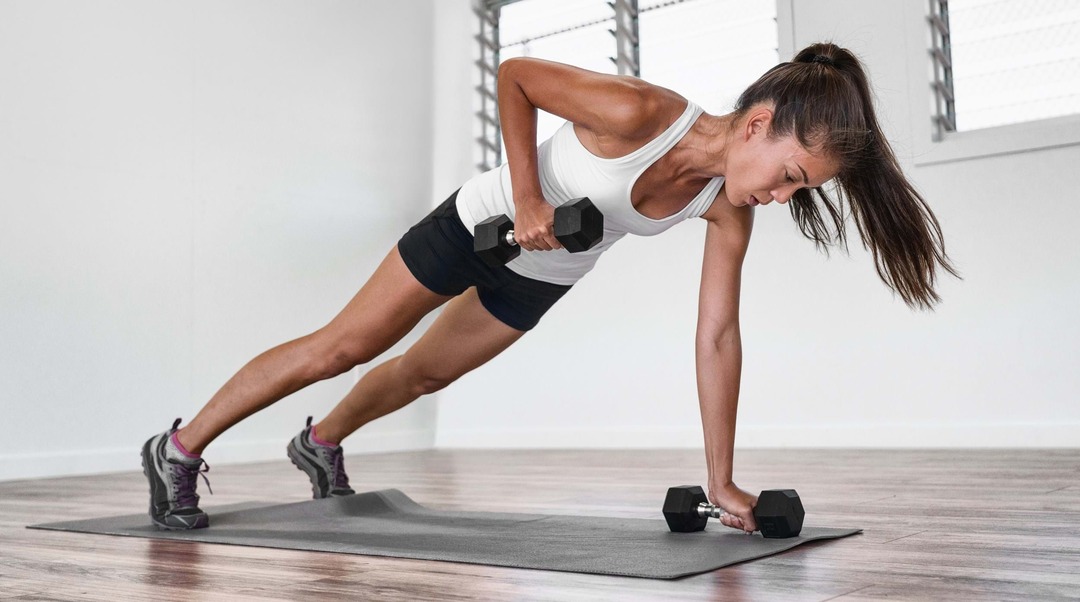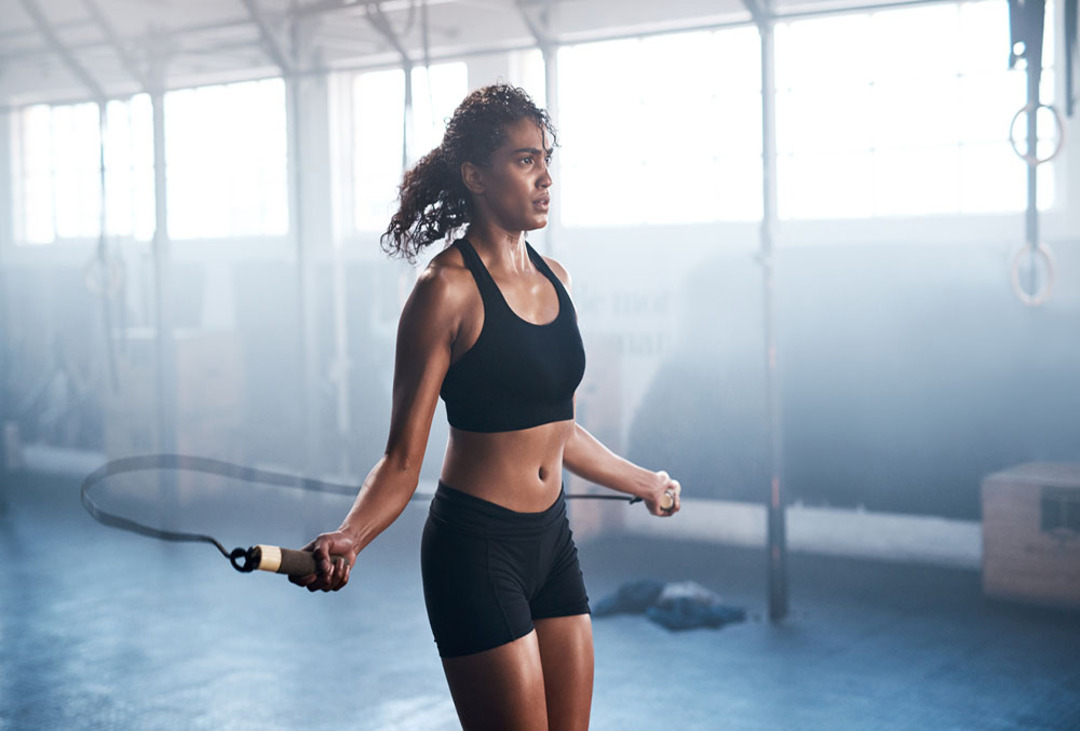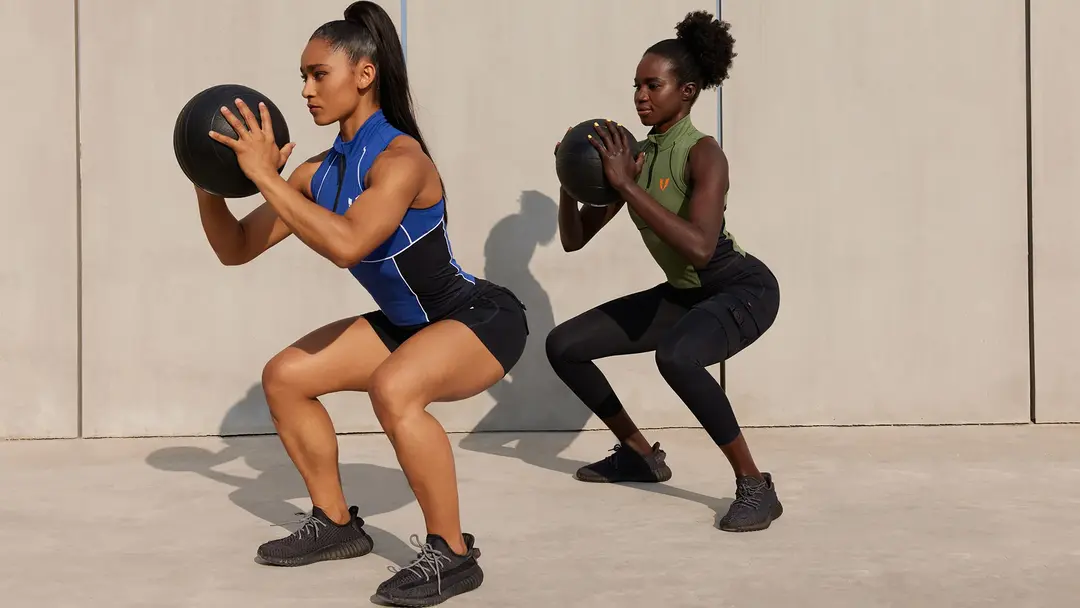15 Best HIIT Workouts For Women

Discover 15 HIIT workout for women routines that burn fat fast, boost cardio, and fit into your busy schedule, no gym required.
Balancing work, family, and fitness can make it challenging to find time for exercise, so many women turn to high-intensity interval training for a quick calorie burn, core strength gains, and a metabolic boost. In Workout Apps For Women, HIIT routines offer short bodyweight circuits, interval workouts, low-impact options, and progressive training plans that cater to both home workouts and gym sessions alike.
This guide provides clear, practical, and credible guidance on effective HIIT exercises, sample sessions, form tips, and recovery cues that you can incorporate into your routine.
To put these tips into practice, GetFit AI's AI fitness app creates short HIIT sessions, provides simple video cues, and adjusts intensity so you can fit effective and safe workouts into busy days.
Summary
- HIIT is extremely time-efficient, with a 20-minute HIIT session burning as many calories as a 60-minute jog, and some 20-minute protocols yielding up to 300 calories per session.
- Brief, maximal intervals produce rapid physiological gains, with studies reporting up to a 15% improvement in aerobic capacity within a few weeks and a 5% reduction in body fat after 8 weeks.
- Programming and spacing matter; most women should aim for two to three HIIT sessions per week, on nonconsecutive days, as their metabolism can remain boosted by roughly 10% for up to three days after a hard session.
- Mistaking breathlessness for effectiveness increases the risk of injury and fatigue, so use objective signals, such as a 5 to 7 percent drop in jump height or rep speed across a microcycle, to indicate that you should reduce intensity.
- Track progress with two focused performance markers and test every 2 to 4 weeks, for example, pairing a 20m sprint with average Tabata rep count to guide load and recovery decisions.
- When HIIT is incorporated into life stages and recovery, women experience significant benefits, including research-backed reports of a 25% greater fat loss compared to traditional routines and a metabolic uplift that lasts up to 48 hours.
- This is where GetFit AI's AI fitness app comes in; it generates athlete-modeled progressions, adjusts interval density and recovery recommendations based on recent performance data, and provides conversational coaching to adapt or to modify sessions when recovery signals decline.
15 Best HIIT Workouts For Women

These 15 HIIT moves are a compact, athlete-modeled kit you can use to target power, strength, speed, and core resilience in short, measurable sessions. Use each exercise with high intent, progress from simple to loaded variations, and track performance—those micro gains add up faster than you think.
1. Jumping Jacks
Jumping jacks are a classic HIIT move that warms up the whole body and gets your heart pumping quickly.
Steps
- Stand straight with feet together and arms by your sides.
- Jump your feet out wider than shoulder-width while raising your arms overhead.
- Quickly jump back to the starting position.
- Repeat at high intensity for 20 seconds, then rest for 10 seconds.
2. Burpees
Burpees are full-body exercises that build strength and cardiovascular endurance fast.
Steps
- Start standing with your feet wider than shoulder-width apart, and place your hands on the floor as you squat down.
- Kick your feet back into a plank while keeping your body straight.
- Jump feet forward towards your hands and then explosively jump up into a standing.
- Work for 20 seconds at top effort, then rest 10 seconds.
3. Push-Ups
Push-ups strengthen the chest, shoulders, and triceps while engaging the core for stability.
Steps
- Begin in a plank, hands shoulder-width apart and feet together.
- Keep a straight spine, pull your belly in to engage your core.
- Lower your body by bending your elbows to the sides, then push back up.
- Modify by dropping knees if needed.
- Perform for 20 seconds with 10 seconds rest between rounds.
4. Mountain Climbers
Mountain climbers activate multiple muscles, including shoulders, abs, and legs, and increase agility.
Steps
- Assume a high plank position with hands below your shoulders, arms extended, and body straight.
- Quickly drive one knee toward your chest, then switch legs in a running motion.
- Keep your torso stable without rocking side to side.
- Repeat for 20 seconds, then rest 10 seconds.
5. Squats
Squats engage the thighs, hamstrings, and glutes, helping to build lower-body power.
Steps
- Stand with feet hip-width apart.
- Bend your knees and lower your hips, ensuring your knees stay aligned over your toes without extending past them.
- Push through your heels to return to standing, squeezing glutes at the top.
- Repeat with a steady pace for 20 seconds, rest for 10 seconds.
6. Sit-ups
Sit-ups are an effective core exercise targeting the abdominal muscles.
Steps
- Lie on your back with knees bent and hands behind your head.
- Tilt your chin slightly upward; engage your core muscles to lift your torso until your elbows touch your knees.
- Slowly lower back down to the ground.
- Perform for 20 seconds at high intensity, then rest 10 seconds.
- Repeat for 8 rounds or about 4 minutes.
7. Jump Rope
Jump rope workouts boost cardiovascular fitness and improve coordination.
Steps
- Using a jump rope, jump continuously for 20 seconds at a high pace.
- Rest for 10 seconds between sets.
- Repeat for 8 rounds or a total of 4 minutes.
- Cool down with 5 minutes of stretching or light cardio.
8. Jump Squats
Jump squats powerfully target the lower body muscles, including glutes and quads.
Steps
- Start in a squat stance with feet hip-width apart.
- Push explosively through your heels to jump upward, fully extending your legs at the apex.
- Land back softly in the squat position and repeat.
- Perform for 20 seconds, then rest for 10 seconds.
9. Kettlebell Swings
Kettlebell swings engage multiple muscle groups through dynamic, swinging motions.
Steps
- Hold a kettlebell with both hands.
- Swing it forward using hip thrusts while keeping your arms straight.
- Alternate between right-hand swings, two-handed swings, and left-hand swings in 20-second intervals.
- Work through 8 rounds with 10-second rest periods.
10. Russian Twist
Russian twists strengthen the oblique muscles and improve core rotation.
Steps
- Sit with legs extended and torso leaning back, forming a V-shape with your body.
- Hold a kettlebell (optional) and twist your torso from side to side while keeping your legs steady.
- Perform eight rounds of 20-second high-intensity intervals, resting for 10 seconds between each round.
- Conclude with a 5-minute cooldown, followed by a brief stretch or light cardio.
11. Lunges
Lunges are excellent for strengthening the core, glutes, and quadriceps.
Steps
- From a standing position, step your left leg back into a reverse lunge.
- Push through your right heel to return to standing.
- Lift your left leg forward to a 90-degree angle.
- Repeat the cycle continuously, alternating legs.
12. Lunge Jump
Lunge jumps combine plyometrics with lunges to boost explosive power.
Steps
- Warm up with light cardio or stretching.
- Perform continuous lunge jumps, switching legs mid-air for one minute.
- Rest for one minute afterward.
- Repeat for 8 rounds with rest intervals in between.
13. Box Jumps
Box jumps develop explosive strength, speed, and agility through plyometric training.
Steps
- Stand before a platform or box that is 12–18 inches high.
- Position feet slightly apart, hips back, and swing arms.
- Swing your arms forward and jump explosively onto the box, landing softly.
- Step down one foot at a time.
- Perform at full effort for 20 seconds, then rest 10 seconds. Repeat for 8 rounds.
14. Plank
Planks build core stability and strengthen abdominal muscles.
Steps
- Start on your hands and knees. Lower onto your forearms with elbows under your shoulders.
- Form a straight line from head to heels, supported by your heels and forearms.
- Hold this position for 20 seconds.
- Rest for 10 seconds and repeat for 8 rounds or about 4 minutes.
15. High Knees
High knees raise heart rate and engage the hips, thighs, and core dynamically.
Steps
- Stand tall and run in place by quickly lifting your knees to hip height.
- Keep thighs parallel to the floor.
- Perform with maximum effort for 20 seconds, then rest for 10 seconds.
- Repeat for 8 rounds.
Programming notes and how to get measurable progress
What matters here is structuring these moves into sessions that target specific qualities. Use 20/10 Tabata sets for anaerobic power, 30/30 or EMOMs for volume and skill, and 4 to 6 sets for strength-focused intervals. For contested time windows, remember that a 20-minute HIIT session can burn as many calories as a 60-minute jog, which explains why short, focused sessions often outperform longer, lower-intensity workouts in terms of time efficiency. Also, keep load progression and movement quality central; add weight or reduce rest only when mechanics hold.
On progressions, testing, and what to measure
Choose two performance markers per block, for example, 20m sprint time and average Tabata rep count, then test every 2 to 4 weeks. After coaching athletes aiming to reclaim or surpass their past 1500m PRs across 12-week cycles, the pattern became clear: integrating short, repeatable high-intensity intervals with targeted strength sessions restored speed and confidence more quickly than endless slow miles. Track objective variables, then let those numbers guide variance.
Status quo disruption: the standard approach and a better way
Most athletes stitch workouts together from generic circuits because they are easy to follow and feel productive. That approach works at first, but as goals become specific and competition returns, sessions fragment, progress stalls, and form degrades because programming lacks individualized load and recovery plans. Platforms like GetFit AI generate athlete-modeled progressions and offer conversational coaching, which helps athletes maintain consistent overload while preserving technique, thereby reducing guesswork that would otherwise slow long-term gains.
Common mistakes and how to avoid them
The most significant error is mistaking breathlessness for effectiveness. If the form collapses, the set becomes a risk of injury, not a conditioning exercise. Another failure mode is chasing volume without specificity; volume helps until it interferes with recovery for strength or speed. Prioritize movement quality, then gradually increase intensity, and schedule restorative microcycles to consolidate gains instead of eroding them.
A quick programming primer you can use tomorrow.
Pick three moves that cover power, unilateral strength, and core, then run two rounds of 20/10 for each movement with 60 seconds between circuits. Measure rep quality or movement speed rather than total reps. Reassess after two weeks and adjust load or rest to keep the sessions progressive and athlete-focused.
HIIT’s calorie efficiency and higher intensity are potent tools, but use them with the discipline of an athlete, not the scatter of a fad routine; remember that HIIT can burn up to 30% more calories than other forms of exercise, so dose intelligently and track the variables that matter.
There is more to this than exercises and intervals; the next section will reveal the physiological levers at play, which changes how you program everything.
What is HIIT?

HIIT stands for High-Intensity Interval Training, a model of conditioning that alternates short, maximal-effort work with brief recovery to drive rapid physiological adaptations. Think of it as targeted stress with built-in recovery, designed to improve speed, power, and cardiovascular capacity without endless mileage.
How does HIIT change performance so quickly?
A primary pathway is neuromuscular recruitment, where brief, all-out efforts preferentially activate fast-twitch fibers, improving the rate of force development, which is beneficial for sprinting and explosive movements. At the same time, short intense intervals trigger mitochondrial and enzymatic adaptations that raise aerobic efficiency, which is why a 2025 study reported that HIIT can improve aerobic capacity by up to 15% in just a few weeks. Those two changes, power and aerobic gain, work together: you get faster recovery between repeats and higher sustainable output on the next hard rep.
What tangible outcomes should you expect and when?
Training adaptations follow a timeline. Neural and coordination gains appear within days to two weeks, while strength and power improvements occur in 3 to 6 weeks, and measurable body composition shifts are observed a bit later, under disciplined programming. In fact, that same 2025 paper found that [participants experienced a 5% reduction in body fat percentage after 8 weeks of HIIT, which highlights that short, intense protocols can produce visible changes if volume, load, and recovery are managed.
Who needs to modify the approach, and how should it be modified?
This model is not one-size-fits-all. When coaching women balancing hormonal conditions or chronic stress, a consistent pattern appears: treating HIIT as the only path to results leads to stress, missed workouts, and stalled progress. If someone feels chronically depleted, consider reducing the interval length, increasing recovery time, or substituting a focused strength block. The goal is to achieve progressive overload while maintaining proper form, rather than relying on perpetual maximal effort. Many women regain momentum when workouts are framed as athlete-style training cycles, rather than relentless cardio sprints.
Why movement quality beats arbitrary intensity
When form breaks, benefits vanish and risk rises. Use objective cues, such as movement velocity, rep quality, and short performance tests, to determine when to add load or reduce volume. Subjective markers matter too, especially for women tracking cyclical recovery needs; if sleep, mood, or steady-state power drops, that is your signal to back off for a microcycle. Treat freshness as part of training, not an optional extra.
Most people follow cookie-cutter HIIT because it is simple and feels productive, which works at first, but it creates two predictable costs: inconsistent progression and rising injury risk as intensity compounds. Platforms like GetFit AI provide teams and athletes with a different path; they generate individualized, athlete-modeled progressions and offer conversational coaching to adjust load and technique in real-time, allowing users to maintain overload while protecting recovery and movement quality.
Think of HIIT like a sprint interval ladder, not an endless race; when you climb with measured steps, the view changes without wrecking your legs.
The next question cuts deeper than whether HIIT works, and it will change the way you judge effectiveness.
Related Reading
- Workout Apps For Women
- Beginners' Workout For Women
- Average Deadlift Weight Kg Woman
- Upper Body Workout For Women
- Leg Day Workout for Women
Are HIIT Workouts Effective?

HIIT works, but only when you treat intensity as a programmable variable, not a badge of honor. Done right, it drives measurable fat loss and cardiovascular gains quickly; done wrong, it becomes chronic stress that erodes performance and consistency.
Who needs to change the standard HIIT template?
After coaching women through multiple 8- to 12-week training blocks, the pattern was consistent: athletes with hormonal sensitivity or persistent fatigue would crash when every session demanded maximal effort. For those athletes, the solution was not ditching HIIT; it was reprioritizing recovery and swapping some high-density intervals for shorter, higher-quality bursts, along with deliberate strength work, which preserved progress while reducing burnout.
How should you judge whether a session helped or hurt?
Treat readiness like a simple dashboard, not a mood. Track your morning resting heart rate, jump height, or short sprint power, and give special weight to HRV shifts. A sustained rise in resting heart rate or a 10 percent drop in HRV across three mornings signals that you should reduce your intensity. Use short, repeatable performance checks, not guilt, to decide when to push and when to back off.
What does objective progress actually look like?
Real-world outcomes matter more than how hard you gas out. Clinical reviews show that participants experienced a 10% reduction in body fat after 12 weeks of HIIT. Such changes are achievable when intensity, nutrition, and recovery are aligned and the program is tailored to the individual trainee.
How do you dose intervals without guessing?
Shift from "go hard until you fail" to three controllable levers: interval length, work-to-rest ratio, and movement quality. Start with shorter intervals and conservative density, then increase either work duration or reduce rest every two to four weeks only if your objective markers stay positive. Think of this like tuning an engine, not flooring the gas; small, repeatable gains in speed or rep quality beat random maximal efforts.
Why session length still matters for busy schedules
Time efficiency is functional, but only when matched to recovery capacity. Sometimes, a shorter, sharper session is superior because it preserves training quality throughout the week. For example, HIIT sessions lasting 20 minutes can burn up to 300 calories, which explains why short, precise sessions often win out for busy athletes, but only if they are dosed intelligently.
Most women start with off‑the‑shelf HIIT because it is simple and feels productive. That familiar approach works at first, but the hidden cost becomes apparent as stalled strength, increased cortisol levels, and missed sessions when life's pressures rise. Platforms like AI fitness apps offer athlete-modeled, individualized plans and in-chat coaching that automatically adjust interval density, periodize recovery, and provide technique cues in real-time, helping users maintain progress without turning fitness into a stressor.
Ready to train like the legends and finally achieve the body you've always wanted? GetFit AI's AI fitness trainer app lets you follow the exact workout routines that made Arnold Schwarzenegger, Kobe Bryant, Cristiano Ronaldo, Serena Williams, and 11+ other elite athletes into champions, and you can also chat with them whenever you need guidance or motivation; download the #1 rated AI fitness app for free today to get fit for less than the cost of a single month's gym membership.
That solution sounds tidy, but the next question about timing and recovery exposes the tradeoffs that actually determine whether HIIT helps or hurts.
Related Reading
- Workout Plans For Women
- Free Workout Apps For Women
- Workout Routine For Women
- Full Body Workout For Women
How Often Should Women Do HIIT Workouts?

I recommend two to three HIIT sessions per week, spaced on nonconsecutive days and adjusted according to how your energy, sleep, and daily stress levels respond. That frequency provides the training stimulus you need, while leaving room for strength work, technique, and recovery that actually convert sessions into lasting gains.
Why does spacing matter for metabolic and hormonal balance?
This pattern appears across many training blocks: when HIIT days cluster without purposeful recovery, short-term wins turn into longer-term drift, where energy and sleep slip before strength or speed improve. Evidence supports why timing matters; according to Rafique 'Flex' Cabral, maintaining a routine that involves HIIT training three to four times a week will help compound that post-workout effect on your metabolism, which is why you should think about session placement across a multi-week block, not only how many you do each week.
How long does the metabolic lift actually last after a session?
This is a constraint-based decision: if your metabolism stays boosted for several days, the next hard session becomes a cumulative stressor rather than a fresh stimulus. That matters because HIIT’s impact on people’s metabolism lingers for some time — Reed estimates it bolsters metabolism up to 10% for three days after a workout, so stacking maximal sessions inside that window can multiply physiological load and blunt recovery.
Most people treat frequency as an all-or-nothing choice. What happens then?
Most athletes manage their week by squeezing in everything that feels urgent: HIIT, a strength day, a social run, and maybe a long weekend class, because that schedule is familiar and efficient. That works until fatigue accumulates, technique degrades, and motivation drops. Platforms like GetFit AI offer an alternative: they generate athlete-modeled progressions that adjust interval density and session type based on your recent training and calendar, and they let you swap a planned HIIT for a restorative strength or mobility option through conversational coaching, preserving progression without adding mental overhead.
When should you consider adding a third HIIT day?
If you are holding quality across two weeks of repeatable performance checks, increasing frequency can be appropriate, but only as a controlled variable. Add a third session for a single microcycle, then track whether short performance markers, subjective energy, and sleep quality remain stable for 10 to 14 days. If any of those decline, scale back immediately. Treat the extra session as an experiment with clear success criteria, rather than a permanent increase, until it proves sustainable.
Who should start with fewer sessions, and how should they progress?
If you have irregular cycles, chronic stress, or are recovering from an injury, start with one HIIT session and one focused strength or technical session per week. Then, add a second HIIT session only when recovery signals are consistently positive, completing a whole training block. This constraint-based approach protects hormones and immune function while still letting you build toward more intense athlete-style conditioning.
A simple analogy to keep it practical
Think of frequency like seasoning a stew: a little concentrated spice enhances flavor, too much masks everything and ruins the meal. Do HIIT with the same restraint, and you get precise results without the breakdown.
That pattern sounds tidy, but the next part reveals the surprising payoffs and tradeoffs you feel when frequency, hormones, and performance finally align.
What are the Benefits of HIIT Workouts for Women?

HIIT gives women outsized returns when you treat intensity as a tool, not a badge. Programmed around life stage, recovery, and clear performance markers, it speeds fat loss, preserves muscle, and keeps training sustainable and measurable.
How should HIIT change across your cycle and life stage?
When we adjusted interval density to match weeks of higher energy versus lower energy within a training block, adherence and strength held steady instead of slipping. Practically, that means scheduling your toughest power intervals during higher-energy windows and swapping a hard session for a shorter, quality-focused set, along with mobility work, when recovery flags appear, so that you can maintain progressive overload without chronic fatigue. This constraint-based approach protects hormones and continuity, which is why programmable plans, not one-size templates, matter.
How do you make HIIT protect strength and bone health?
Treat HIIT sessions as capacity builders for strength, not replacements for it. Add one loaded compound movement or a high-force plyometric at the start of a block, then use shorter metabolic intervals later to protect neuromuscular quality. That order preserves fast-twitch recruitment and contributes to bone loading, which reduces long-term fracture risk while keeping the conditioning stimulus efficient.
What objective signals should you track to judge whether HIIT is working?
Replace the subjective “I gassed out” with two short, repeatable checks, for example, a 10-second jump test and a 30-second maximal rep count, measured every two weeks. If the jump height drops or the rep speed slows by more than 5 to 7 percent across a microcycle, reduce the interval density or increase the rest. These metrics provide an absolute decision rule, allowing intensity increases to be deliberate rather than reactive.
How does nutrition and timing amplify HIIT benefits?
Pairing targeted protein intake and a modest carbohydrate window around sessions preserves muscle repair while fueling high-quality effort. Small, practical rules work best: consuming 20 to 30 grams of protein within an hour after a hard session and a light carbohydrate snack 30 to 60 minutes before a maximal interval can help maintain power and recovery without overcomplicating daily life.
Why HIIT can actually accelerate fat loss for women
Research from [Dr. Stacy Sims shows that women who engage in HIIT can experience a 25% increase in fat loss compared to traditional exercise routines. This matters because targeted, time-efficient sessions produce visible body composition gains when paired with recovery and strength training. That same leverage comes from the lingering metabolic lift, as Virago Fitness reports that HIIT workouts can increase metabolic rate for up to 48 hours after exercise; therefore, how you space sessions changes the total weekly stimulus.
What breaks most DIY HIIT programs, and how to avoid it?
The familiar approach is to treat every session as a maximal effort because it feels productive. That works in the short term, but the hidden cost is progressive fatigue, missed quality, and stalled strength as sessions accumulate. Platforms like GetFit AI step in here: teams find that athlete-modeled progressions, individualized load adjustments, and in-chat coaching replace guesswork, allowing users to maintain overload while reducing the blind spots that cause burnout and injury, thereby preserving progress as training complexity increases.
A simple analogy to keep this practical
Think of HIIT like tuning a racebike, not riding flat out until something breaks; small changes in gearing and cadence create faster, more sustainable speed than constant full-throttle efforts.
That tidy plan sounds like an endpoint, but the next part exposes a surprising way to make elite athlete routines feel personally possible.
Make Your Favorite Athlete Your Fitness Trainer | Try GetFit AI's AI Trainer App for Free Today

I know that fitting HIIT workouts for women around work, family, and recovery can feel impossible, so I encourage you to try a plan that adapts to your energy level and measures your progress. GetFit AI has real traction, with over 1 million downloads, and 90% of users report improved fitness levels within 3 months, which suggests athlete-modeled, individualized HIIT and strength-focused intervals deliver fast, measurable results.
Related Reading
- Lower Abs Workout for Women
- Ab Workout Women
- Hiit Workout Women
- Arms Workout for Women



.png)











